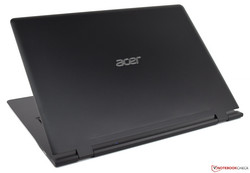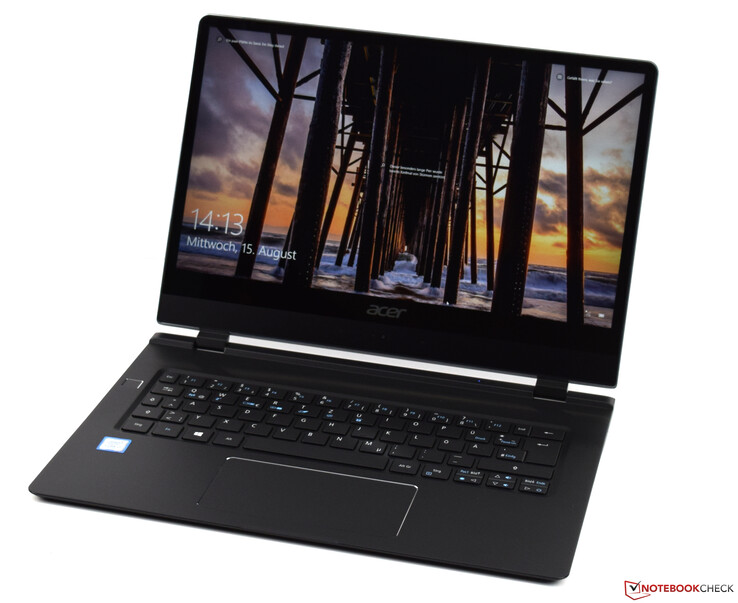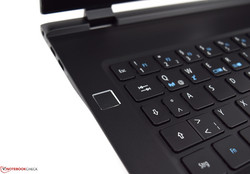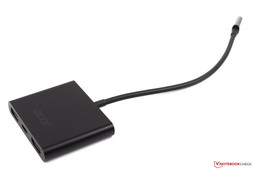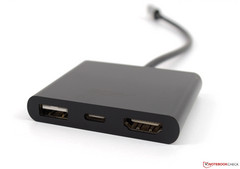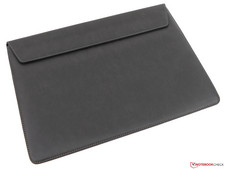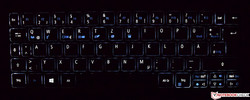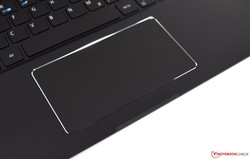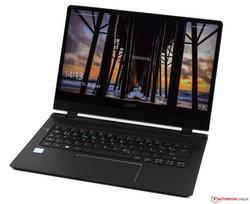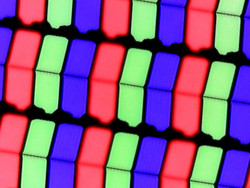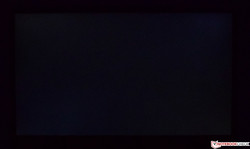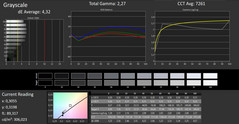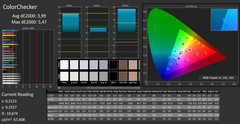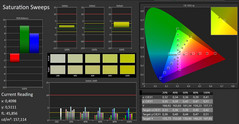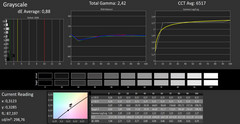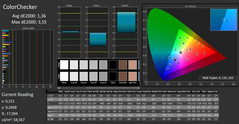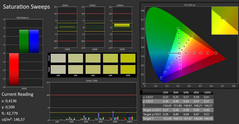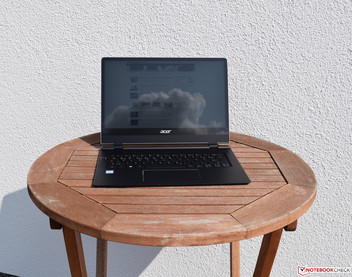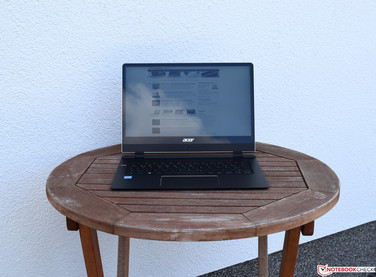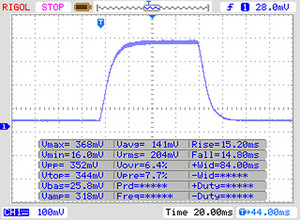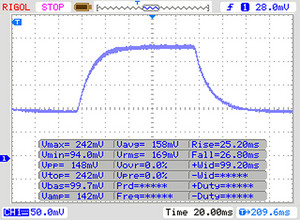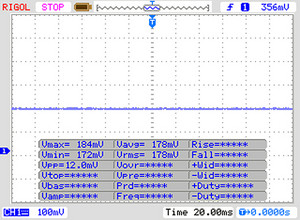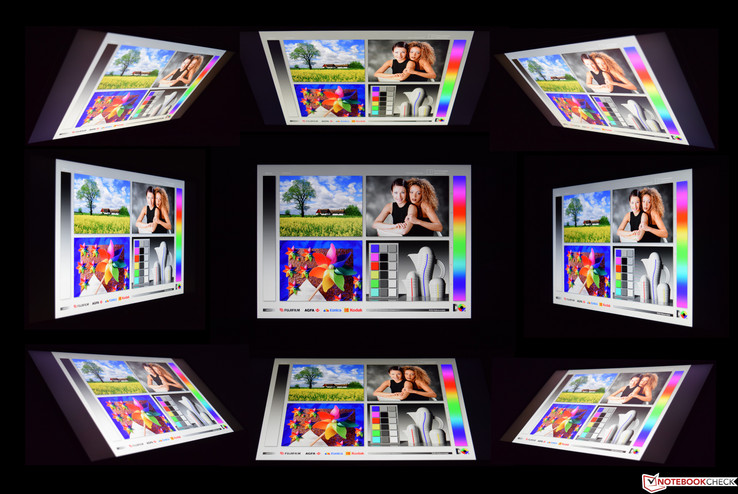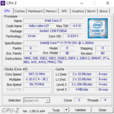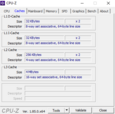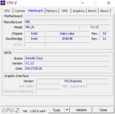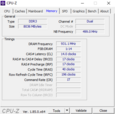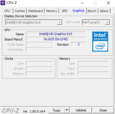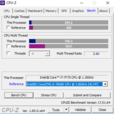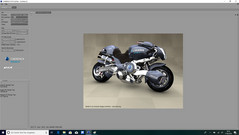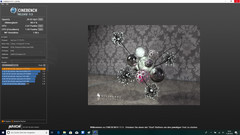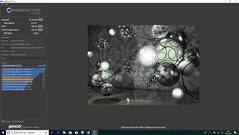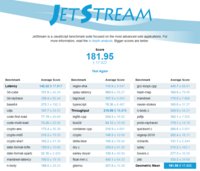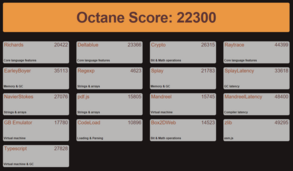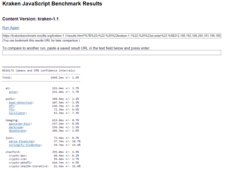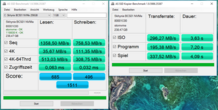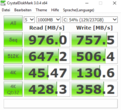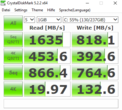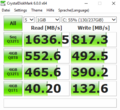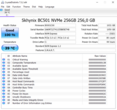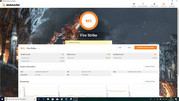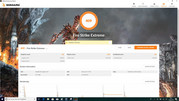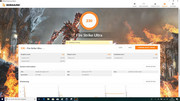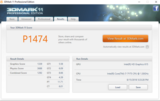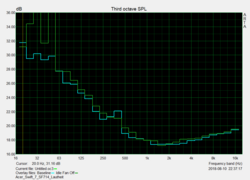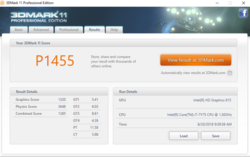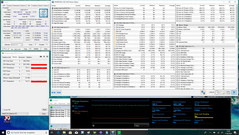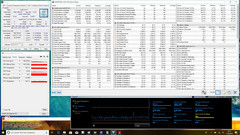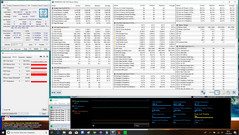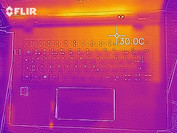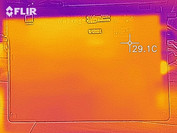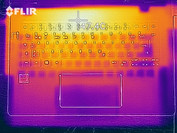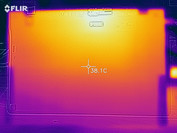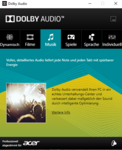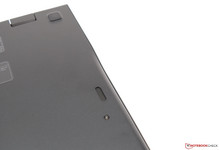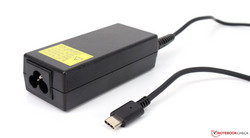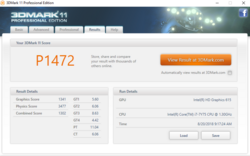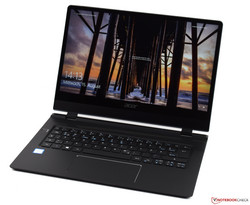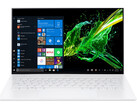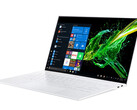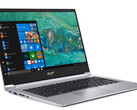Acer Swift 7 SF714-51T (Core i7-7Y75, 256 GB, FHD, Touch) Laptop Review

The Acer Swift 7 SF714-51T mainly stands out because of its extremely compact design. The new Swift 7 is equipped with a larger 14-inch display that supports multi-touch, but there is little to get excited about under the hood. The device is equipped with an Intel Core i7-7Y75 Y-series processor, 8 GB of DDR3 RAM and a 256 GB NVMe SSD. Y-series processors consume considerably less power than their U-series counterparts, which means that the Swift 7 has no fan and is passively cooled.
It is worth bearing in mind that the Swift 7’s configuration is fixed besides the SSD, for which Acer has several options on its website.
You would be forgiven for thinking that Acer compromised on the components used in the new Swift 7 because of its compact design. However, the device comes with an LTE module as standard, which is not something that we see in most consumer-grade laptops.
The new Swift 7 costs a whopping 1,699 Euros (~$1,973) at the time of writing, the justifications for which we will be discussing at the end of this review. We have selected some equivalently priced devices against which to compare the Swift 7. We have included a table detailing our comparison devices and a summary of their specifications below.
| Fujitsu Lifebook U938 | Apple MacBook 12 | Xiaomi Mi Air 13.3 | HP Spectre 13 | Dell XPS 13 | Acer Swift 7 SF713 | |
| CPU | Intel Core i5-8250U | Intel Core m3-7Y32 | Intel Core i5-8250U | Intel Core i7-8550U | Intel Core i5-8250U | Intel Core i5-7Y54 |
| GPU | Intel UHD Graphics 620 | Intel HD Graphics 615 | Nvidia GeForce MX150 | Intel UHD Graphics 620 | Intel UHD Graphics 620 | Intel HD Graphics 615 |
| Display | 13.3-inch 1,920 x 1,080 (IPS) | 12-inch 2,304 x 1,440 (IPS) | 13.3-inch 1,920 x 1,080 (IPS) | 13.3-inch 1,920 x 1,080 (IPS) | 13.3-inch 3,840 x 2,160 (IPS) | 13.3-inch 1,920 x 1,080 (IPS) |
| RAM | 12 GB DDR4 | 8 GB DDR3 | 8 GB DDR4 | 8 GB DDR3 | 8 GB DDR3 | 8 GB DDR3 |
| Storage | 256 GB SSD | 256 GB SSD | 256 GB SSD | 512 GB SSD | 256 GB SSD | 256 GB SSD |
| Rating | 89% | 90% | 85% | 87% | 88% | 86% |
Case
The Swift 7 has an elegant and compact case that is made of aluminum. The device has a minimal design with only the Acer logo adorning the display lid. Unfortunately, the stylish matte-black finish is a fingerprint magnet, which somewhat detracts from the otherwise premium design. Moreover, the slim design comes at a cost to the stability. Our test device is particularly easy to twist and visibly bows to pressure at various points. By contrast, the display is more rigid than the rest of the device, but we could easily get the display to distort by applying pressure to the lid.
The display can be opened to an angle of 180 ° but not one-handed. This should not be a problem in daily use. While the display hinges are stiff they cannot prevent the display from noticeably rocking, but not overly so, when using the device.
Overall, the Swift 7 looks smart and is well crafted, but we would have preferred to see Acer use sturdier case materials.
Size Comparison
The Swift 7 is just 8.98 mm thick, which makes it the thinnest device in its class. The rest of the device measures 32.8 x 23.7 cm, which makes our test device larger than all our comparison devices; these all have smaller displays though.
The Swift 7 weighs 1.2 kg, making it one of the lightest 14-inch laptops currently on the market. This should appeal to those who are fans of portability; the power supply only adds 291 g to the device’s overall carry weight too.
Connectivity
The Swift 7’s thin profile makes it impossible to equip the device with conventional ports. The Swift 7 has two USB 3.1 Type-C ports like its predecessor, but Acer has moved these to the rear of the left-hand side to the right of the headphone jack. Acer has placed the nano-SIM card tray and power button on the opposite side, which leaves plenty of space for a microSD card reader which the Swift 7 sadly lacks. This omission means that you will have to carry around adapters if you need to connect USB Type-A devices or any form of card-based external storage. Acer includes a USB Type-C hub in the box that is equipped with one USB Type-A port, an HDMI port and USB Type-C power out. You will need to carry an additional memory card adapter though.
Incidentally, we could charge our test device with either USB Type-C port using the included charger.
Communication
Our test device is equipped with an Intel Dual Band Wireless AC 7265 module that provides support for Bluetooth 4.0. Our test device achieved 542 Mb/s in the iperf3 Client receive test and 632 Mb/s in the transmission test, which puts the Swift 7 in the middle of our comparison devices. Only the Apple MacBook 12 finished higher than the Swift 7 in both tests.
The Swift 7 can be connected to a wired Internet connection, but you will need a USB Type-C to Ethernet adapter; Acer does not include one in the box. We had no issues with establishing a wired connection with our test device and could even achieve a Gbit connection with the right adapter.
Security
We welcome the inclusion of a fingerprint sensor that supports Windows Hello, which is located to the left of the Tab key. Once set up with the short Windows Hello process, the fingerprint sensor worked reliably in unlocking our test device quickly. The fingerprint sensor is the only hardware security feature that Acer includes in the Swift 7.
Accessories
The Swift 7 comes with a compact 45 W USB Type-C charger, a USB Type-C hub and a matching black sleeve. Both these accessories are welcome additions, particularly the USB Type-C hub as having an option to connect USB Type-A devices is still a must for most users in 2018. The sleeve is well-made and there is a flap along the longer edge that is affixed with two magnets. It is worth bearing in mind that the sleeve is only big enough for the device, so the charger and hub must be stored separately.
Maintenance
The Swift 7 lacks a maintenance cover, but the degree of maintenance is limited by the device’s fan-less design and that most of the components are soldered to the motherboard. The only components that could be swapped or upgraded are the battery, the SSD and the Wi-Fi module.
With that being said, removing the bottom cover should be approached with caution. We did not remove our test device’s bottom case as we only had it on loan from Acer.
For those of you that are still interested in removing the bottom case, you will need to remove both the screws that are around its edge and those that are under the device’s rubber feet. We would then recommend prying up the bottom case with a plastic pry tool to avoid any damage.
Warranty
The Swift 7 comes with Acer’s standard 24 months warranty. Please see our Guarantees, Return policies and Warranties FAQ for country-specific information.
Input Devices
Keyboard
Acer has completely redesigned the keyboard, a major change of which is the inclusion of white backlighting. Acer has recessed the keyboard so that the keys are level with the palm rest. The keys measure 15 x 15 mm, which should be sufficiently sized for most users, while the white labeling is easy to read. Unfortunately, the typing experience is lacking. The keys have a shallow stroke and a barely noticeable pressure point, the combination of which makes typing feel spongy. We would have preferred a firmer typing experience and the degree of sponginess will bother frequent typists. There are also some compromises with key sizes and key placement that will take some getting used to. For example, Acer has included half-sized arrow keys, a small caps lock key and a relatively narrow backspace key. Moreover, the function keys are integrated within the number row while the keyboard shortcuts are integrated within the first line of letter keys.
Touchpad
The touchpad measures 12.1 x 6.5 cm, which is 1.9 cm narrower than the one found in the last Swift 7. The touchpad is still sufficiently sized for multi-touch gestures though and its finish is pleasantly smooth. While fast and precise navigation is possible, we noticed some inaccuracies towards the touchpad’s edges.
We should point out that this is a pure touchpad without a click mechanism. The lack of a click makes using the touchpad a struggle in daily life as simple gestures like drag and drop feel cumbersome without having the ability to first click then drag. We would have preferred Acer to have equipped the Swift 7 with a ClickPad instead.
Touchscreen
The touchscreen is a useful additional input method, albeit not a strictly necessary one as the Swift 7 is a traditional laptop rather than a convertible. However, the degree to which a touchscreen is useful in a traditional laptop is subjective. The touchscreen responded accurately and quickly throughout our tests with no issues.
Display
The Swift 7 is equipped with a 14-inch IPS display with a 1920x1080 native resolution. This is the only display that Acer currently offers with the Swift 7 too.
Our test device is equipped with an AU Optronics display that achieves an average maximum brightness of 309 cd/m² in our tests. While this makes the Swift 7’s display brighter than the HP Spectre, it is darker than all our other comparison devices. By contrast, the 4K Dell XPS 13 9370 has a 52% brighter display than the Swift 7. Our test device has a 0.26 cd/m² black value that is on par with most of the competitors, but its 1,169:1 contrast ratio is beaten by three of our five comparison devices. This is still an impressive contrast ratio though, but colors will look more vibrant on both the Xiaomi Mi Notebook Air and the Acer Swift 7 SF713-51.
Positively, our test device has no backlight bleed, nor does it use pulse-width modulation (PWM) to regulate brightness.
| |||||||||||||||||||||||||
Brightness Distribution: 83 %
Center on Battery: 232 cd/m²
Contrast: 1169:1 (Black: 0.26 cd/m²)
ΔE ColorChecker Calman: 3.99 | ∀{0.5-29.43 Ø4.77}
calibrated: 1.36
ΔE Greyscale Calman: 4.32 | ∀{0.09-98 Ø5}
94% sRGB (Argyll 1.6.3 3D)
59% AdobeRGB 1998 (Argyll 1.6.3 3D)
64.6% AdobeRGB 1998 (Argyll 3D)
94.2% sRGB (Argyll 3D)
63.5% Display P3 (Argyll 3D)
Gamma: 2.27
CCT: 7261 K
| Acer Swift 7 SF714-51T AUO B140HAN05.1, 1920x1080, 14" | Acer Swift 7 SF713-51 Chimei Innolux, N133HCE-GP1, 1920x1080, 13.3" | Fujitsu Lifebook U938 Sharp LQ133M1JW28, 1920x1080, 13.3" | Xiaomi Mi Notebook Air 13.3 2018 SHARP LQ133M1JW15, 1920x1080, 13.3" | HP Spectre 13-af033ng AU Optronics AUO422D, 1920x1080, 13.3" | Dell XPS 13 9370 i5 UHD ID: Sharp SHP148B, Name: LQ133D1, Dell P/N: 8XDHY, 3840x2160, 13.3" | |
|---|---|---|---|---|---|---|
| Display | -1% | 4% | 4% | -1% | 7% | |
| Display P3 Coverage (%) | 63.5 | 64.6 2% | 67.5 6% | 67.8 7% | 64 1% | 68.9 9% |
| sRGB Coverage (%) | 94.2 | 89.1 -5% | 94.5 0% | 91.6 -3% | 90.7 -4% | 98.4 4% |
| AdobeRGB 1998 Coverage (%) | 64.6 | 64.8 0% | 68.7 6% | 69.8 8% | 65.1 1% | 69.5 8% |
| Response Times | 25% | 10% | 12% | 34% | -36% | |
| Response Time Grey 50% / Grey 80% * (ms) | 51 ? | 31 ? 39% | 43 ? 16% | 39.6 ? 22% | 27 ? 47% | 67.2 ? -32% |
| Response Time Black / White * (ms) | 30 ? | 27 ? 10% | 29 ? 3% | 29.3 ? 2% | 24 ? 20% | 41.6 ? -39% |
| PWM Frequency (Hz) | 217 ? | 220 ? | 2500 ? | |||
| Screen | -4% | 5% | -19% | 5% | 6% | |
| Brightness middle (cd/m²) | 304 | 359 18% | 344 13% | 370 22% | 304 0% | 496.4 63% |
| Brightness (cd/m²) | 309 | 344 11% | 320 4% | 355 15% | 287 -7% | 469 52% |
| Brightness Distribution (%) | 83 | 92 11% | 77 -7% | 90 8% | 80 -4% | 84 1% |
| Black Level * (cd/m²) | 0.26 | 0.25 4% | 0.31 -19% | 0.23 12% | 0.21 19% | 0.5 -92% |
| Contrast (:1) | 1169 | 1436 23% | 1110 -5% | 1609 38% | 1448 24% | 993 -15% |
| Colorchecker dE 2000 * | 3.99 | 4.57 -15% | 2.72 32% | 6.9 -73% | 3.66 8% | 2.9 27% |
| Colorchecker dE 2000 max. * | 5.47 | 9.25 -69% | 5.92 -8% | 12.2 -123% | 5.66 -3% | 5.26 4% |
| Colorchecker dE 2000 calibrated * | 1.36 | 1.4 -3% | ||||
| Greyscale dE 2000 * | 4.32 | 5.2 -20% | 2.74 37% | 7.4 -71% | 3.51 19% | 3.9 10% |
| Gamma | 2.27 97% | 2.47 89% | 2.38 92% | 1.76 125% | 2.55 86% | 2.066 106% |
| CCT | 7261 90% | 6887 94% | 6794 96% | 7529 86% | 6955 93% | 7169 91% |
| Color Space (Percent of AdobeRGB 1998) (%) | 59 | 58 -2% | 61 3% | 59 0% | 63.9 8% | |
| Color Space (Percent of sRGB) (%) | 94 | 89 -5% | 94 0% | 91 -3% | 98.2 4% | |
| Total Average (Program / Settings) | 7% /
0% | 6% /
5% | -1% /
-10% | 13% /
8% | -8% /
1% |
* ... smaller is better
Acer has equipped the Swift 7 with a decent display. Fonts look crisp and images are rendered sharply. Moreover, colors are displayed clearly thanks to the good contrast ratio. The display is relatively color accurate by default too. Default Delta E 2000 deviations are only slightly higher than ideal values, and this can be significantly improved with additional calibration. We have linked our preferred ICC profile to use on your device should you so wish.
The measured color-space coverage is good enough for semi-professional photo editing, but the 59% AdobeRGB accuracy is too low for professional use. This is a trend among all our comparison devices too though.
Unfortunately, we cannot recommend the Swift 7 for outdoor use. The highly reflective display finish and the relatively low maximum brightness make using the Swift 7 in direct sunlight impractical. We would recommend finding a shady spot if you must use the device outside though.
Display Response Times
| ↔ Response Time Black to White | ||
|---|---|---|
| 30 ms ... rise ↗ and fall ↘ combined | ↗ 15 ms rise | |
| ↘ 15 ms fall | ||
| The screen shows slow response rates in our tests and will be unsatisfactory for gamers. In comparison, all tested devices range from 0.1 (minimum) to 240 (maximum) ms. » 79 % of all devices are better. This means that the measured response time is worse than the average of all tested devices (20.2 ms). | ||
| ↔ Response Time 50% Grey to 80% Grey | ||
| 51 ms ... rise ↗ and fall ↘ combined | ↗ 25 ms rise | |
| ↘ 26 ms fall | ||
| The screen shows slow response rates in our tests and will be unsatisfactory for gamers. In comparison, all tested devices range from 0.165 (minimum) to 636 (maximum) ms. » 87 % of all devices are better. This means that the measured response time is worse than the average of all tested devices (31.6 ms). | ||
Screen Flickering / PWM (Pulse-Width Modulation)
| Screen flickering / PWM not detected | |||
In comparison: 53 % of all tested devices do not use PWM to dim the display. If PWM was detected, an average of 8081 (minimum: 5 - maximum: 343500) Hz was measured. | |||
Performance
Acer has made all the right choices when it comes to making the Swift 7 as portable as possible. The device is fan-less thanks to its low power Intel Core i7-7Y75 processor. This CPU will be powerful enough for most common office and multimedia programs, but you will have to make do with Intel HD Graphics 615 for graphics performance.
Overall, the component selection is well matched as demonstrated by the low DPC latencies.
Processor
Acer has included the low-power Core i7-7Y75 probably to fit with the Swift 7’s compact design and intended use. The Core i7-7Y75 is a dual-core Y-series processor, which means that it has only a 4.5 W TDP and a 1.3 GHz base clock speed that can turbo boost up to 3.6 GHz when required. While the Swift 7 should have better performance than its predecessor, it cannot compete with our more powerful comparison devices. The Core i7-7Y75 simply cannot compete against quad-core processors like the Intel Core i7-8550U or the Intel Core i5-8250U in terms of raw performance. The Swift 7 also falls 15% from the class average in the Cinebench R15 multithreaded benchmark.
It is worth noting that our test device performed equally well on battery power as it did on mains power.
Further benchmarks for the Core i7-7Y75 can be found here.
| Cinebench R10 | |
| Rendering Single CPUs 64Bit | |
| Average of class Subnotebook (11450 - 15516, n=2, last 2 years) | |
| Acer Swift 7 SF714-51T | |
| Average Intel Core i7-7Y75 (n=1) | |
| Acer Swift 7 SF713-51 | |
| Rendering Multiple CPUs 64Bit | |
| Average of class Subnotebook (53207 - 66113, n=2, last 2 years) | |
| Acer Swift 7 SF714-51T | |
| Average Intel Core i7-7Y75 (n=1) | |
| Acer Swift 7 SF713-51 | |
* ... smaller is better
The passive cooling effectively cools the Core i7-7Y75 even under load, as demonstrated by the consistent Cinebench R15 multithreaded benchmark loop. Our test device only dropped from an initial score of 260 points to around 250 points, which represents around a 4% drop in performance.
System Performance
PCMark benchmark results also reflect the comparatively meager CPU performance that Cinebench demonstrated. While the Swift 7 is on par with the Apple MacBook 12 it cannot compete with our more powerful comparison devices.
Synthetic benchmarks only tell half the story though. The Swift 7 performs well in daily use and the fast SSD ensures that the device boots quickly. Our test device even copes with having multiple browser tabs open without any noticeable slowdown.
| PCMark 8 Home Score Accelerated v2 | 2933 points | |
| PCMark 8 Creative Score Accelerated v2 | 3614 points | |
| PCMark 8 Work Score Accelerated v2 | 3970 points | |
| PCMark 10 Score | 2068 points | |
Help | ||
Storage Devices
Our test device is equipped with an SK Hynix 256 GB NVMe SSD and offers the same volume of storage as its predecessor, which came with a slower SSD. By contrast, the SSD in our test device is an average of 36% faster than the Kingston SSD used in the last Swift 7. While the SK Hynix drive has relatively good 4K read and write speeds, it cannot compete with the Samsung PM961 SSD used in both the HP Spectre and the Mi Notebook Air.
| Acer Swift 7 SF714-51T SK Hynix BC501 NVMe 256 GB | Acer Swift 7 SF713-51 Kingston RBU-SNS4180S3256GG | Fujitsu Lifebook U938 Micron 1100 MTFDDAV256TBN | Apple MacBook 12 2017 Apple SSD AP0256 | Xiaomi Mi Notebook Air 13.3 2018 Samsung PM961 MZVLW256HEHP | HP Spectre 13-af033ng Samsung PM961 NVMe MZVLW512HMJP | Dell XPS 13 9370 i5 UHD Toshiba XG5 KXG50ZNV256G | Average SK Hynix BC501 NVMe 256 GB | |
|---|---|---|---|---|---|---|---|---|
| CrystalDiskMark 3.0 | -36% | -41% | -14% | 25% | 12% | -5% | ||
| Read Seq (MB/s) | 976 | 431.2 -56% | 464.9 -52% | 955 -2% | 1288 32% | 907 -7% | 1055 ? 8% | |
| Write Seq (MB/s) | 758 | 401 -47% | 401 -47% | 899 19% | 1160 53% | 878 16% | 753 ? -1% | |
| Read 512 (MB/s) | 647 | 283.7 -56% | 320.2 -51% | 658 2% | 751 16% | 515 -20% | 811 ? 25% | |
| Write 512 (MB/s) | 506 | 313.6 -38% | 335.2 -34% | 579 14% | 843 67% | 546 8% | 492 ? -3% | |
| Read 4k (MB/s) | 45.47 | 36.62 -19% | 26.45 -42% | 9.721 -79% | 59.2 30% | 60 32% | 41.5 ? -9% | |
| Write 4k (MB/s) | 130.6 | 76.1 -42% | 79.8 -39% | 12.78 -90% | 146.9 12% | 144 10% | 106 ? -19% | |
| Read 4k QD32 (MB/s) | 428.3 | 329.4 -23% | 246.5 -42% | 521 22% | 425.9 -1% | 543 27% | 328 ? -23% | |
| Write 4k QD32 (MB/s) | 358.2 | 325.6 -9% | 277.2 -23% | 370.1 3% | 325 -9% | 476 33% | 307 ? -14% |
Graphics Card
The Swift 7 is equipped with the same Intel HD Graphics 615 iGPU as its predecessor. However, the boost clock speed is slightly higher at 1,050 MHz, which explains why the new Swift 7 scores higher in graphics benchmarks than its predecessor. The HD Graphics 615 is around 20% slower than the Intel UHD Graphics 620 used in the XPS 13 9370, the LifeBook U938 and the HP Spectre, but it is blown away by the Nvidia GeForce MX150 GPU with which the Mi Notebook Air is equipped, despite this being the much slower 1D12 variant.
Positively, the RAM operates in dual-channel mode, which allows the Swift 7 to get the most from its HD Graphics 615. Overall, graphics performance is currently even above the class average.
Further benchmarks of the Intel HD Graphics 615 can be found here.
| 3DMark 11 Performance | 1474 points | |
| 3DMark Ice Storm Standard Score | 53841 points | |
| 3DMark Cloud Gate Standard Score | 5601 points | |
| 3DMark Fire Strike Score | 861 points | |
| 3DMark Fire Strike Extreme Score | 409 points | |
Help | ||
Gaming Performance
The Swift 7 is a subnotebook designed for mobile use and not with gaming in mind. As such, while the Swift 7 can run some simple or older games, it cannot cope with more modern titles.
| low | med. | high | ultra | |
|---|---|---|---|---|
| BioShock Infinite (2013) | 48.6 | 28.3 | 24.4 | 7.9 |
| Battlefield 4 (2013) | 37.3 | 26.9 | 19.1 | 6.4 |
| Sims 4 (2014) | 155.1 | 94.2 | 43.5 | 29.6 |
| Rise of the Tomb Raider (2016) | 14.2 | 9.1 |
Emissions
Fan Noise
The Swift 7 SF714 is a passively cooled device so there is no fan noise. Hence, the device always runs silently. However, we did notice some quiet electronic noises when there was significant data access. We could only hear this when practically putting our ear to the device though, so you should not notice this when sat at a typical distance from the device.
Temperature
While Acer claims that the new Swift 7 manages its surface temperatures well, our test device heats up more than expected. The top portion of the device reaches around 40 °C under load with the warmest area reaching 44.7 °C. These are not dangerous or uncomfortable temperatures though and are only because the device is passively cooled. By contrast, surface temperatures on the Mi Notebook Air reach over 50 °C despite being actively cooled.
We also ran a series of one-hour stress tests to check internal temperatures. During a Prime95 stress test, CPU core temperatures peaked at 78 °C, but the CPU operated at an average of 1.75 GHz, which is considerably higher than the 1.3 GHz base clock speed. This means that the Swift 7 should not thermal throttle under heavy CPU workloads. However, our test device cannot maintain peak performance under combined CPU and GPU workloads as both share the small 4.5 W TDP. When running a combined FurMark and Prime95 stress test the CPU only clocks between 600 and 700 MHz while the GPU clocks at between 450 and 550 MHz. Core temperatures settled at around 64 °C during this stress test because of performance fluctuations.
The stress test did not have a lasting negative impact on 3D performance either as demonstrated by the 3DMark11 benchmark result that we ran after our stress testing.
(±) The maximum temperature on the upper side is 44.7 °C / 112 F, compared to the average of 35.9 °C / 97 F, ranging from 21.4 to 59 °C for the class Subnotebook.
(±) The bottom heats up to a maximum of 42.8 °C / 109 F, compared to the average of 39.3 °C / 103 F
(+) In idle usage, the average temperature for the upper side is 24 °C / 75 F, compared to the device average of 30.8 °C / 87 F.
(+) The palmrests and touchpad are cooler than skin temperature with a maximum of 29.6 °C / 85.3 F and are therefore cool to the touch.
(±) The average temperature of the palmrest area of similar devices was 28.2 °C / 82.8 F (-1.4 °C / -2.5 F).
| Acer Swift 7 SF714-51T HD Graphics 615, i7-7Y75, SK Hynix BC501 NVMe 256 GB | Acer Swift 7 SF713-51 HD Graphics 615, i5-7Y54, Kingston RBU-SNS4180S3256GG | Fujitsu Lifebook U938 UHD Graphics 620, i5-8250U, Micron 1100 MTFDDAV256TBN | Apple MacBook 12 2017 HD Graphics 615, m3-7Y32, Apple SSD AP0256 | Xiaomi Mi Notebook Air 13.3 2018 GeForce MX150, i5-8250U, Samsung PM961 MZVLW256HEHP | HP Spectre 13-af033ng UHD Graphics 620, i5-8550U, Samsung PM961 NVMe MZVLW512HMJP | Dell XPS 13 9370 i5 UHD UHD Graphics 620, i5-8250U, Toshiba XG5 KXG50ZNV256G | |
|---|---|---|---|---|---|---|---|
| Heat | -5% | 2% | -8% | -10% | -13% | -14% | |
| Maximum Upper Side * (°C) | 44.7 | 45.7 -2% | 39.3 12% | 38.9 13% | 50 -12% | 41.2 8% | 43.2 3% |
| Maximum Bottom * (°C) | 42.8 | 48.7 -14% | 43.1 -1% | 42.5 1% | 47 -10% | 44.2 -3% | 46.2 -8% |
| Idle Upper Side * (°C) | 25.5 | 25.5 -0% | 25.4 -0% | 30.6 -20% | 27 -6% | 32.1 -26% | 29.8 -17% |
| Idle Bottom * (°C) | 24.8 | 25.2 -2% | 25.6 -3% | 30.8 -24% | 28 -13% | 32.8 -32% | 32.8 -32% |
* ... smaller is better
Speakers
There are two small speakers on the underside of the device. While the sound quality is impressive, the sound reproduction is significantly muffled when the device is placed on a soft surface. Equally, we could not adjust the sound with any included audio profiles. Speech is clearly understood at maximum volumes and should be loud enough for making Skype calls without needing to use headphones. The microphone is sufficient in this regard too, although Acer should have included a better-quality microphone and speakers given the Swift 7’s high retail price.
The 3.5 mm jack worked without issue with both external speakers and headphones throughout our tests.
Power Management
Power Consumption
The Swift 7 is an economical device. Our test device consumes between 2.8 W and 7.9 W at idle, which increases to a maximum of 20 W under load. This puts the Swift 7 almost on par with the MacBook 12 in terms of power consumption and 6% more power-efficient than its predecessor. The Swift 7 consumes considerably less than its predecessor when idling though.
The included 45 W power supply will be able to charge the Swift 7 even when it is operating under full load. The power supply can charge our test device via either USB Type-C port.
| Off / Standby | |
| Idle | |
| Load |
|
Key:
min: | |
| Acer Swift 7 SF714-51T i7-7Y75, HD Graphics 615, SK Hynix BC501 NVMe 256 GB, IPS, 1920x1080, 14" | Acer Swift 7 SF713-51 i5-7Y54, HD Graphics 615, Kingston RBU-SNS4180S3256GG, IPS, WLED, 1920x1080, 13.3" | Fujitsu Lifebook U938 i5-8250U, UHD Graphics 620, Micron 1100 MTFDDAV256TBN, IPS, 1920x1080, 13.3" | Apple MacBook 12 2017 m3-7Y32, HD Graphics 615, Apple SSD AP0256, LED IPS, 2304x1440, 12" | Xiaomi Mi Notebook Air 13.3 2018 i5-8250U, GeForce MX150, Samsung PM961 MZVLW256HEHP, IPS, 1920x1080, 13.3" | HP Spectre 13-af033ng i5-8550U, UHD Graphics 620, Samsung PM961 NVMe MZVLW512HMJP, IPS, 1920x1080, 13.3" | Dell XPS 13 9370 i5 UHD i5-8250U, UHD Graphics 620, Toshiba XG5 KXG50ZNV256G, IPS, 3840x2160, 13.3" | Average Intel HD Graphics 615 | Average of class Subnotebook | |
|---|---|---|---|---|---|---|---|---|---|
| Power Consumption | -6% | -19% | 5% | -76% | -38% | -81% | -21% | -89% | |
| Idle Minimum * (Watt) | 2.8 | 4.1 -46% | 2.4 14% | 2 29% | 3.9 -39% | 2.8 -0% | 4.3 -54% | 4.12 ? -47% | 3.97 ? -42% |
| Idle Average * (Watt) | 5.5 | 6.4 -16% | 5.5 -0% | 5.4 2% | 7 -27% | 6.2 -13% | 8 -45% | 7.02 ? -28% | 6.83 ? -24% |
| Idle Maximum * (Watt) | 7.9 | 6.8 14% | 6 24% | 6.6 16% | 7.5 5% | 9.4 -19% | 8.1 -3% | 7.89 ? -0% | 8.47 ? -7% |
| Load Average * (Watt) | 18.4 | 16 13% | 31 -68% | 22 -20% | 44.4 -141% | 32.2 -75% | 46.6 -153% | 20 ? -9% | 43.6 ? -137% |
| Load Maximum * (Watt) | 20 | 18.7 6% | 32.6 -63% | 20 -0% | 55.1 -176% | 36.6 -83% | 49.8 -149% | 23.8 ? -19% | 66.6 ? -233% |
| Witcher 3 ultra * (Watt) | 32.8 |
* ... smaller is better
Battery life
The Swift 7 has impressive battery life, underlining its use as a highly portable device. Our test device lasted 19 h 30 m idling, which dropped to a still impressive seven-and-a-half hours in both our H.264 video loop battery test and our Wi-Fi battery test, during which we run a script that simulates the load required to render websites. We set the display brightness to 150 cd/m² for the purposes of these tests. In practical terms, this should mean that the Swift 7 will last for three movies before being recharged.
Our test device fully recharges in just over two hours. We should also point out that the CPU and GPU perform equally well on battery power as they do on mains power. The Cinebench R15 and 3DMark 11 results are almost identical on battery power and mains power.
| Acer Swift 7 SF714-51T i7-7Y75, HD Graphics 615, Wh | Acer Swift 7 SF713-51 i5-7Y54, HD Graphics 615, 41.58 Wh | Fujitsu Lifebook U938 i5-8250U, UHD Graphics 620, 50 Wh | Apple MacBook 12 2017 m3-7Y32, HD Graphics 615, 41.4 Wh | Xiaomi Mi Notebook Air 13.3 2018 i5-8250U, GeForce MX150, 39 Wh | HP Spectre 13-af033ng i5-8550U, UHD Graphics 620, 43 Wh | Dell XPS 13 9370 i5 UHD i5-8250U, UHD Graphics 620, 52 Wh | Average of class Subnotebook | |
|---|---|---|---|---|---|---|---|---|
| Battery runtime | -8% | -3% | 20% | -24% | -4% | -22% | 59% | |
| Reader / Idle (h) | 19.6 | 13.2 -33% | 19.5 -1% | 13 -34% | 14.5 -26% | 30.7 ? 57% | ||
| H.264 (h) | 7.5 | 6.8 -9% | 7.2 -4% | 8 7% | 10.8 44% | 16.9 ? 125% | ||
| WiFi v1.3 (h) | 7.5 | 7.3 -3% | 8.4 12% | 9 20% | 6.1 -19% | 5.9 -21% | 6.8 -9% | 13.4 ? 79% |
| Load (h) | 2.6 | 3 15% | 2.1 -19% | 1.3 -50% | 1.7 -35% | 1.8 -31% | 1.948 ? -25% | |
| Witcher 3 ultra (h) | 1.4 |
Verdict
Pros
Cons
The Acer Swift 7 SF714 is an ultra-compact subnotebook that is well suited for mobile use. The Swift 7 slightly improves on its predecessor in all areas; the greatest difference is the larger 14-inch multi-touch display. Acer has also revised the chassis to make the new Swift 7 even thinner than its predecessor. Unfortunately, this somewhat compromises stability though.
Acer has maintained the limited port selection with its latest Swift 7, but we welcome the inclusion of an LTE modem. We just wish that Acer had included a memory card reader as this would have added to the device’s flexibility.
We have high praise for the included accessories though. The sleeve has a premium feel to it and is well made. This also applies to the USB Type-C hub, which expands the Swift 7’s port selection to one USB Type-A port and a single HDMI port.
The Acer Swift 7 SF714 improves on its predecessor in all areas, particularly with its larger multi-touch display. The price has also changed, namely upwards. Has Acer missed a trick in this regard though?
A big criticism of the Swift 7 is its pricing. The Acer Swift 7 SF714 costs an eye-watering 1,699 Euros (~$1,973), which is a significantly lower price-performance ratio than its predecessor. Ultimately, potential buyers must decide for themselves whether the innovations and slightly increased performance justify this steep increase in price.
We cannot give the Acer Swift 7 SF714 a clear buy recommendation solely because of its high retail price.
Another smaller gripe we have is with the touchpad. Its lack of a click mechanism makes using the device that much more difficult in daily use.
Overall, the Acer Swift 7 SF714 is a smart and ultra-mobile device with impressive battery life that is let down by its high price.
Acer Swift 7 SF714-51T
- 08/28/2018 v6 (old)
Sebastian Bade


